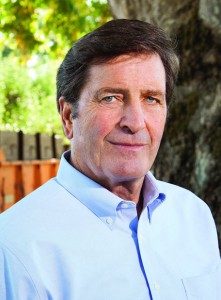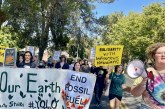 The California League of Conservation Voters (CLCV) and the League of Conservation Voters (LCV) Action Fund announced today their endorsement of John Garamendi (D-Fairfield, CA) for re-election to Congress. The LCV Action fund noted Congressman Garamendi’s strong conservationist record, commitment to growing our clean energy economy, and longstanding support for protecting California’s vast natural resources.
The California League of Conservation Voters (CLCV) and the League of Conservation Voters (LCV) Action Fund announced today their endorsement of John Garamendi (D-Fairfield, CA) for re-election to Congress. The LCV Action fund noted Congressman Garamendi’s strong conservationist record, commitment to growing our clean energy economy, and longstanding support for protecting California’s vast natural resources.
“With his extensive background as a public servant, Congressman Garamendi has proven forward-looking and strategic in his fight to better our country’s environment,” said Gene Karpinski, President of the LCV Action Fund. “He recognizes our moral obligation to act on climate change and has, on many occasions, made progress in reducing our reliance on the fossil fuels that cause climate change.”
“Again and again, Congressman Garamendi has earned Californians’ trust, keeping our state’s priceless natural landscapes in prime condition,” said Sarah Rose, CEO of the CLCV. “His dedication to reducing our nation’s reliance on fossil fuels has stretched his entire career, from the California State legislature to the U.S. Congress; undoubtedly, he will continue to make California a healthy place for all of our families.”
“I’m proud to have earned the endorsement of the League of Conservation Voters Action Fund. Congress needs leaders who acknowledge the overwhelming scientific consensus that humans contribute to the climate crisis and are proactive in proposing commonsense solutions. In this election, I face a climate change denier with an atrocious environmental record. With powerful conservation voices like the LCV Action Fund having my back, I’m confident we’ll make sure the 3rd District remains a district where the need for clean air and clean water is taken seriously,” said Congressman Garamendi.
As a member of the Safe Climate Caucus, Congressman Garamendi recognizes the severe threat climate change poses to our country and is devoted to reducing our reliance on the fossil fuels that cause climate change through investments in clean energy and conservation. Garamendi’s Make It In America legislation would increase America’s investment in American-made renewable energy sources like solar and wind power. Garamendi is also a supporter of Home Star legislation, which offers incentives to homeowners and businesses to make their buildings more energy efficient. As a California state legislator, he wrote the first state alternative energy tax credit in the United States.
During his various roles serving California – state Assemblyman, Majority Leader of the California State Senate, Lieutenant Governor of California, U.S. Congressman – Congressman Garamendi has fought to protect California’s stunning natural landscapes. In the state legislature he led efforts to preserve Lake Tahoe, authoring legislation that forever protected the lake from development, and he’s also an outspoken advocate for California’s San Joaquin River Delta and Mono Lake. Furthermore, as the Deputy Secretary of the Interior, he helped shape the Clinton Administration’s policies on national parks, clean energy, and conservation.
Congressman Garamendi’s voting record earned him an admirable 96% score on LCV’s National Environmental Scorecard in 2013 and a lifetime score of 92%. In comparison Garamendi’s opponent Dan Logue, a member of the “Flat Earth Five” for his climate change denialism, has consistently voted against environmental protections, receiving a 15% score on the California League of Conservation Voters State Scorecard and a lifetime score of 12%. The non-partisan Scorecard is the nationally accepted yardstick used to rate members of Congress on environmental and clean energy issues. For more information, visit http://scorecard.lcv.org/
Logue, a climate change denialist, has called the climate crisis a “hoax”. He led the Prop 23 campaign in 2010 to repeal California’s landmark greenhouse gas emission goals. That measure, opposed by then-Governor Arnold Schwarzenegger and then candidates for Governor Jerry Brown and Meg Whitman, was rejected by more than 60% of California voters. Between Prop 23 and his campaigns for Congress, Assembly, and Senate, Dan Logue has collected over $9 million in donations from oil and coal interests.






Are you endorsing him, or putting out a Press Release? 🙂
I always seem to cringe when I see “Climate Change” coupled with the words “severe”, “crisis”, and “threat”. I wish someone would tell me what time frame this is all to occur, since I look at the lava flow in Hawaii, and no one seems to do anything but get out of its way?
When it comes to air quality and the math, I know the first 90% is achievable with current technology. If just exporting that at no cost to other polluting countries would reduce it, why are we expensively going for the last 5 or 10% when the other countries export the old junk we had to continue making the bad air?
What if we still had horses and no steam engines, which arguably wasted forest resources and created its own “climate change”? I see on the flag of Lebanon a Cedar Tree, which I read used to be ubiquitous there? Would we still have this “threat”?
People need to do a better job splainin it to us. I grew up on a farm, and I love all the farms around. Farmers are not interested in killing the land.
Sorry, John, you lost my vote. I used to vote for you. No more.
Your endorsement of Sites Reservoir and your endorsement of the so-called Yolo Rail Relocation makes me believe you are returning the favor for construction and union campaign contributions, so they can pour lots of cement on really bad projects. Sites has almost no water sources, its offline storage and all the water has to be pumped uphill into it from the Sacramento River. Instead, we should be storing the water in underground aquifers.
The so-called Yolo Rail Relocation is a cluster-F of unrelated projects that could be solved for a fraction of the cost, except for the federal money used to open up land for developers, which should be fraud, but is instead a “federal grant”. The whole thing is based on a lie about flood control. Not that flood control isn’t needed, but the rail component can be solved for a few million instead of over $100 million. West Sac needs to apply on their own, put in 1000′ of connector track, remove the trestle and call it good. Spending $100 million to remove a track that has one round trip train a day on it is a crime, well it is not but it should be. You are friends with Angelo Tsoupokulops and he’s behind this and you are doing him a favor and you know it. This is a web of tangled legal federal grant fraud.
So you lost my vote. Bye John.
Alan, once again you express your fairy tale fantasy about what the Yolo Rail Relocation project is, and in the process describe perfectly what it is not. You keep talking about solving the $5 billion actuarial flood risk on the East Side Levee of the Sacramento River (from Natomas to Pocket) “for a fraction of the cost.” Yet, when asked to explain what your inexpensive solution is for that problem, you never provide a single piece of information, just platitudes like “1000 feet of connector track.” You expect to connect Westt Sacramento and Woodland with 1,000 feet of track? The distance across the Yolo Bypass alone is eight times 1000 feet.
The project frees up one foot of freeboard across the whole with of the Yolo Bypass just north of the I-5 Causeway east of Woodland. At that point the Bypass is 8,300 feet wide. At Natomas the width of the Sacramento River is 650 feet (or less). At Tower Bridge it is 600 feet. At Pocket it is 550 feet. That amounts to at least a 12 to 1 ratio, which means that for every inch of additional carrying capacity in the Yolo Bypass one foot of water depth is removed at Natomas (also referred to as one foot of increased freeboard). Increased freeboard in a flood event means less hydrostatic pressure on the East Side Levee … which significantly reduces the flood risk to the million residents in the metropolitan area east of that levee. However, that one foot of carrying capacity can not be achieved without removing the trestle. Remove the trestle and you terminate a privately-owned business, and then you have to purchase the trestle and the right of way which is privately owned. Relocating that business to a new right of way is no more expensive than eminent domain purchase costs of the business and land would be.
Further, who is at risk for the insurance liability if the east side levee fails? The federal government … specifically FEMA. So the federal government has significant “skin in the game.” That is why they are involved.
There has not been a single cement company that has shown any interest in the rail relocation.